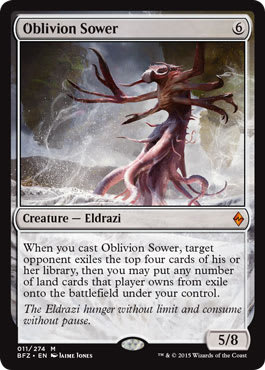Temur Aetherworks is the best deck in Standard. The pieces of the deck are strong enough that, even in games where you can’t find Marvel, the deck can execute a reasonable midrange beatdown plan. The best draws are so good that you can beat even decks that are specifically built to counter your strategy. So what’s left to explore? Well, given that Marvel decks are starting to adapt to fight one another, you can start looking for a Marvel strategy that goes bigger than the others and is less likely to fail when they try to interact. This deck may well be that next level:
Temur Marvel ? Amonkhet Standard | Negi_NegiMaster, 5-0 Standard League
- Creatures (12)
- 1 Greenwarden of Murasa
- 3 Ulamog, the Ceaseless Hunger
- 4 Oblivion Sower
- 4 Rogue Refiner
- Instants (12)
- 1 Commit // Memory
- 3 Glimmer of Genius
- 4 Censor
- 4 Harnessed Lightning
- Sorceries (7)
- 1 Baral's Expertise
- 2 Crush of Tentacles
- 4 Attune with Aether
- Artifacts (7)
- 3 Woodweaver's Puzzleknot
- 4 Aetherworks Marvel
- Lands (22)
- 1 Mountain
- 2 Island
- 6 Forest
- 1 Lumbering Falls
- 4 Aether Hub
- 4 Botanical Sanctum
- 4 Shrine of the Forsaken Gods
- Sideboard (15)
- 1 Baral's Expertise
- 1 Dissenter's Deliverance
- 1 Sphinx of the Final Word
- 1 World Breaker
- 2 Radiant Flames
- 2 Tireless Tracker
- 3 Magma Spray
- 4 Negate
It’s easy to see Rogue Refiner, Woodweaver's Puzzleknot, and Aetherworks Marvel and scroll right past this decklist, but that’s a mistake you don’t want to make. Sure, it’s still an Aetherworks Marvel deck, and you’re still looking to use Harnessed Lightning and Censor as interaction while you set up your Marvel tricks. You’re still hoping to hit Ulamog off of your Marvel activations. But that’s where the similarities end.
Your backup plan isn’t Chandra, Torch of Defiance. Instead, this deck is playing the full four Shrine of the Forsaken Gods and Oblivion Sowers. These cards, combined with Greenwarden of Murasa, give you a fundamentally different and more overwhelming gameplan than other takes on Aetherworks Marvel. This deck doesn’t just have the option of casting Ulamog sometimes; it’s built around making that reality happen.
If you Marvel early on in the game and hit Ulamog, you’re still vulnerable to removal spells like Declaration in Stone. The inclusion of Oblivion Sower means that you can just take those lands and put them to use helping you cast your giant threats, all while potentially exiling your opponent’s powerful top end straight from their library.
If you want a build of Marvel that has a better fail case and can more easily cast giant threats, this is a great place to start. There’s even a little bit of flex for you to find room to enhance that aspect of the gameplan with effects like Nissa's Renewal or more colorless threats like the last copy of Ulamog, some World Breakers, or even Kozilek, the Great Distortion.























